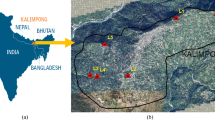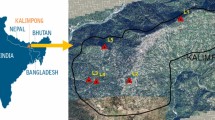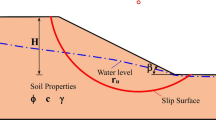Abstract
Slopes in geotechnical and mining engineering are the most crucial geo-structure. Predicting or forecasting the stability or instability of the slope and then classifying the slope accordingly helps in mitigating the risks and enhancing the design by maximizing the safety. Computing techniques have overpowered the analytical and statistical models used for predicting the stability of the slopes. To reduce the uncertainties and ambiguity of the previously used models, lately, researchers have come up with the novel techniques for Slope Stability Classification (SSC) which are Random Forest, Gradient Boosting Machine, Extreme Gradient Boosting, Boosted Trees and Classification and Regression Trees. These computational algorithms are employed in this research paper and the slope details are taken from a literature i.e. 221 input datasets are used and slopes are classified accordingly using the mentioned models. The relation between the inputs such as height (H), slope angle (β), cohesion (c), pore water pressure ratio (ru), unit weight (γ), angle of internal friction (φ) and slope stability (output) is established and slopes are categorized according to their failure and stability. Performance analysis is done thereafter to analyses and compare different models and let the readers and researchers know that which model sufficed and fitted best to the study.






Similar content being viewed by others
Data Availability
Data has been used from a literature work by Zhou et al. in 2019.
References
Breiman L (1996) Bagging predictors. Machine Learn 24(2):123–140
Breiman L (2001) Random forests. Machine Learn 45(1):5–32
Breiman L, Friedman GH, Olshen RA (2017) Classification and regression trees Routledge
Breiman L, Friedman F, Olshen R, Stone C (1984) Classification and regression trees. Wadsworth, Belmont
Chen T, Guestrin C (2016t) Xgboost: A scalable tree boosting system. In Proceedings of the 22nd acm sigkdd international conference on knowledge discovery and data mining (pp. 785–794).
De’Ath G (1999) New statistical methods for modeling species-environment relationships, Ph.D. thesis, James Cook University, Townsville, Australia.
Dietterich TG (2000) An experimental comparison of three methods for constructing ensembles of decision trees: Bagging, boosting, and randomization. Machine Learn 40(2):139–157
Fan J, Upadhye S, Worster A (2006) Understanding receiver operating characteristic (ROC) curves. Canadian J Emerg Med 8(1):19–20
Ferentinou MD, Sakellariou MG (2007) Computational intelligence tools for the prediction of slope performance. Comput Geotech 34(5):362–384
Freund Y (1995) Boosting a weak learning algorithm by majority. Inf Comput 121(2):256–285
Freund Y, Schapire RE (1996) Experiments with a new boosting algorithm. icml 96:148–156
Friedman JH (2001) Greedy function approximation: a gradient boosting machine. Annals of statistics 1189–1232.
Friedman JH (2002) Stochastic gradient boosting. Comput Stat Data Anal 38(4):367–378
Friedman N, Getoor L, Koller D, Pfeffer A (1999a) Learning probabilistic relational models. Int Jt Conf Artif Intell 99:1300–1309
Friedman N, Goldszmidt M, Wyner A (1999b) Data analysis with Bayesian networks: A bootstrap approach. In Proceedings of the Fifteenth conference on Uncertainty in artificial intelligence. Morgan Kaufmann Publishers Inc 196–205.
Friedman JH, Hastie T, Tibshirani R (2000) Additive logistic regression: a statistical view of boosting (with discussion and a rejoinder by the authors). Annal Stat 28(2):337–407
Grandvalet Y (2004) Bagging equalizes influence. Machine Learn 55(3):251–270
Hong H, Pourghasemi HR, Pourtaghi ZS (2016) Landslide susceptibility assessment in Lianhua County (China): a comparison between a random forest data mining technique and bivariate and multivariate statistical models. Geomorpholog 259:105–118
Maroco J, Silva D, Rodrigues A, Guerreiro M, Santana I, de Mendonça A (2011) Data mining methods in the prediction of Dementia: A real-data comparison of the accuracy, sensitivity and specificity of linear discriminant analysis, logistic regression, neural networks, support vector machines, classification trees and random forests. BMC Res Notes 4(1):299
Massart DL, Vandeginste BG, Buydens LMC, De Jong S, Lewi PJ, Smeyers-Verbeke J, Mann CK (1998) Handbook of chemometrics and qualimetrics: Part A. Appl Spectrosc 52:302A
Myles AJ, Feudale RN, Liu Y, Woody NA, Brown SD (2004) An introduction to decision tree modeling. J Chemom: A J Chemometrics Soc 18(6):275–285
Schapire RE (1990) The strength of weak learnability. Machine Learn 5(2):197–227
Strobl C, Malley J, Tutz G (2009) An introduction to recursive partitioning: rationale, application, and characteristics of classification and regression trees, bagging, and random forests. Psychol Methods 14(4):323
Terzaghi K (1950) Mechanism of landslides. Application of geology to engineering practice, Geol. Soc. Am 83–123.
Wang HB, Xu WY, Xu RC (2005) Slope stability evaluation using back propagation neural networks. Eng Geol 80(3–4):302–315
Yao X, Tham LG, Dai FC (2008) Landslide susceptibility mapping based on support vector machine: a case study on natural slopes of Hong Kong. China Geomorphol 101(4):572–582
Zhang W, Wu C, Li Y, Wang L, Samui P (2019) Assessment of pile drivability using random forest regression and multivariate adaptive regression splines. Georisk: Assessment and Management of Risk for Engineered Systems and Geohazards 1–14.
Zhou J, Li E, Yang S, Wang M, Shi X, Yao S, Mitri HS (2019) Slope stability prediction for circular mode failure using gradient boosting machine approach based on an updated database of case histories. Saf Sci 118:505–518
Author information
Authors and Affiliations
Corresponding author
Ethics declarations
Conflict of interest
This manuscript deals with AI in Geotechnical structure classification and opens a tunnel for enhancement and improvement of the accuracy of implicit calculations involved in Civil Engineering. Software used: all the models used in this study were developed in R Studio.
Additional information
Publisher's Note
Springer Nature remains neutral with regard to jurisdictional claims in published maps and institutional affiliations.
Rights and permissions
About this article
Cite this article
Bharti, J.P., Mishra, P., moorthy, U. et al. Slope Stability Analysis Using Rf, Gbm, Cart, Bt and Xgboost. Geotech Geol Eng 39, 3741–3752 (2021). https://doi.org/10.1007/s10706-021-01721-2
Received:
Accepted:
Published:
Issue Date:
DOI: https://doi.org/10.1007/s10706-021-01721-2




